The Right Way to Start a Profitable Blog ▷ Earn $5973 Monthly
Today, almost anyone can learn how to create and start a blog and make money online.
Every lucrative online business requires you to run a blog as your web-based showroom.
The good thing about starting a blogging business is that you don’t need an expensive budget or capital to get started.
You can make money online without a blog or website, but you can never earn as much as those who have blogs do.
Therefore, the most successful online entrepreneurs — those who make 100% of their income from the internet — all have their own blogs.
While blogging may sound like a glamorous job, it takes hard and smart work to start and run a successful blog.
The success of millionaire bloggers like Linda Ikeji, Uche Pedro, Makinde Azeez, Remedy Nwankwo, Ajah Excel, Pascal Okafor, Jide Ogunsaya, Abass Toriola, Emenike Emmanuel, Ifiokobong Ibanga, Harsh Agrawal, Neil Patel, Brian Dean and several others makes it look like a bed of roses, but the nights and years of relentless efforts to always ensure there’s relevant information on their blogs for their readers mostly goes unnoticed.
Rather, greed clouds the judgements of most wannabe bloggers, and after making the plunge, fall out in a short time.
Do you have what it takes to start your own blog?
Are you looking to create a blog but don’t know where to begin?
In this article, you’ll be shown how to start and make money from your blog in Nigeria, the United States of America, the United Kingdom, Canada, Australia, Singapore, Germany, Netherlands, Sweden, New Zealand, India, Pakistan, The Philippines, Brazil, South Africa, Ghana, Cameroon, Egypt, Ethiopia, Tanzania, Kenya, Zambia, Zimbabwe, Uganda, Senegal, Dubai, Malaysia, Turkey, Tunisia, Portugal, Italy, Romania, and perhaps anywhere else in the world.
Let’s get started!
What is a Website?
A website is a collection of web pages and related content that is identified by a common domain name and published on at least one web server.
Notable examples are bet9ja.com, wikipedia.org, google.com, facebook.com and amazon.com.
Websites can be used in various fashions: a personal website, a corporate website for a company, a government website, an ecommerce website, a logistics website, a sport betting website, etc.
Websites can be the work of an individual, a business or other organization, and are typically dedicated to a particular topic or purpose, such as news, education, commerce, entertainment, or social networking.
Users can access websites on a range of devices, including desktops, laptops, tablets, and smartphones.
Some websites require user registration or subscription to access content.
Examples of subscription websites include many business sites, news websites, academic journal websites, gaming websites, file-sharing websites, message boards, web-based email, social networking websites.
What is a Blog?
Blogging is the act of writing a post on a blog.
A blog is an online journal or informational website that is regularly updated with articles (called blog posts) about a certain topic.
A blog is a platform where a writer or even a group of writers share their views on an individual subject.
For example, SIWES Beginner is a blog that teaches how to start a profitable blogging business, legitimately make money online, achieve academic success, good health and win sports betting.
You can start a blog on any topic, such as travel, food, parenting, pet, phones, electronics, kitchen appliances, and relationship.
While some people just blog for fun to share their personal life or hobbies, you can also earn money from blogging.
What is the Difference Between a Blog and Website?
Blogs are a type of website.
The only actual difference between a blog and other types of websites is that blogs are updated regularly with new content, which is displayed in reverse chronological order (new blog posts first).
Typical websites are static where content is organized in pages, and they are not updated frequently.
Whereas a blog is dynamic, and it is usually updated more frequently.
Some bloggers publish multiple new articles a day.
In simple terms, all blogs can be a website or part of a website. However, not all websites can be called blogs.
For example, SIWES Beginner is a blog and a website.
Our website has other content which is published in a non-blog format like About Us, and a Contact Page.
Whether you are a business, a non-profit organization, or a professional, adding your own blog to your website can help you attract your target audience, grow your email list, and sell products.
Blogging is really profitable and very lucrative if it’s done the right and smart way.
Through consistency and creating value for your audience, you’ll be successful.
You just have to look for a problem your audiences are trying to solve and create a solution for it.
Steps to Starting a Blog that Makes Money Online
Here are the steps to start a profitable blog online.
1. Choose Your Blogging Niche
This can either be the easiest or the hardest part of starting your blog.
One of the first decisions you make after deciding you want to start a blog is to figure out what you will blog about.
The most important thing at this stage is to choose a niche which you can call yourself an authority (expert) in.
The biggest mistake new bloggers make in such a crowded blogosphere is starting a blog without trying to do something surprising or different.
If you’re blogging just for fun or as a hobby, a defined niche doesn’t matter as much.
But if want to make money blogging, thought must be targeted at a clearly defined audience or topic.
Remember that the goal of professional bloggers is to build a reputation.
Certainly, you cannot build a reputation for everything.
You need to build a reputation for something.
Therefore, before you start a blog, give a long hard thought on what you want to be blogging about.
Ensure to choose something you enjoy writing about and also the topics and information people are searching on the internet for.
Passion is very important in blogging because it takes time and energy to build a reputation and make money from blogs and without passion, you will certainly give up.
To make things easy for you, start and fully focus on one blog niche first. In the long run, you can write on other blog topics.
Note: If you have money to hire quality writers or a team of writers, you can only focus on multi-niche, i.e., writing on different topics. But if you’re a one-man army, focus on a single blog subject first.
This site (SIWES Beginner) was created in January 2019 and primarily focused on education as the main blog niche.
After years of making and learning from my blogging mistakes, becoming an authority and gaining much experience, I diversified to other blog niches aside from education, i.e.; I started writing on different high-demand topics, such as how to start a lucrative blog, legitimately make money online, start business, live healthy, and easily win sports betting.
To discover your passion and interests, you need to brainstorm.
Ask yourself the following questions:
- What topics do I regularly discuss with my friends?
- What solutions and services can I easily provide to individuals and businesses?
- What are my hobbies and talent?
- What type of movies do I watch?
- What do I spend my money on?
- The books and magazines I read?
- What types of websites do I regularly visit?
When picking what to write about, it is very important to choose a niche with a sizable local or international audience.
Do not choose a niche that is so unique that you are virtually the only person interested in it.
If you can’t see yourself writing about your chosen topic long-term, don’t feel that excited about it or don’t have money to hire qualified writers, then pick something else.
Lucrative Blogging Niches Examples include:
- Affordable Apartments
- Agriculture
- Banking and Finance
- Beard Oil
- Book Publishing
- Business Startups
- Celebrities Profile (Net worth)
- Cheap Flight Tickets
- Cheap Hotels
- Cheap Laptops
- Cooking Guide and Tutorials
- Cryptocurrencies
- Education
- Electronics
- Entertainment
- Event Planning
- Fashion Design
- Football News and Correct Prediction (Scores)
- Forex Trading
- Free Browsing Cheats and Tricks
- Healthy Eating
- Job Search
- Kids Security Tips
- Kitchen Appliances
- Latest Phones
- Lifestyle
- Mini importation
- Moringa Benefits
- Movies Reviews
- Music Download
- Natural and Herbal Remedies
- New Baby List
- News and Gossip
- Penis Enlargement
- Prayer Points
- Real Estate
- Relationship and Marriage Advice
- Scar Remover
- Scholarship
- Sexual Health/Fertility
- Skincare
- Sports Betting
- Study Abroad
- Table Manners
- Tech Tutorials and Gadgets
- Travel Abroad
- Weight Loss
These are the best ways to find a topic for your new blog:
- Look at other Blogs – This should be your first port of call. What’s already successful? And what’s missing? Find the gaps in the market.
- Use Google – What are people searching for? Use Google suggested searches and auto-complete to discover what people are looking for – if they’re searching for it, that shows there’s a demand.
- Search Forums for common FAQs – When people can’t find answers to their questions, they go to forums. What are they asking? What do they need advice on? This will show what people are interested in and what there’s a lack of information on.
- Think about different content – Could you do tutorials/how-to guides? Reviews? Interviews? Lists? It might not be what you write about, but how you write, which sets you apart.
Getting even more specific is a good idea; for example, a travel blog about extreme budget travel, an Agric blog about palm oil business or a blog about how to run your own wedding photography business.
Don’t worry if you can’t decide on a niche right now.
Just start by writing about whatever you’re interested in, and you can narrow or change your focus as you go on and see what’s working best for you.
2. Choose Blog Platform
You need to choose the right platform to build your own blog.
A blog platform is an online software that enables you to create and maintain a blog.
You can write, format, and edit your posts, as well as add photos and videos to your posts via your blogging platform.
The blog platform also creates an easy interface for customizing the look and feel of your blog.
They also offer plug-ins and widgets for extending the functionality of your blog and making it more useful to your readers.
Although you can switch your platform, getting it right the first time is very important.
Switching blogging platforms may require some technical skills. So, take your choice of a blog platform serious.
You have two main options for actually setting up a blog–you can use a free blogging platform, or you can create your own website.
For example, you can start a free blog on a platform like WordPress.com, Blogger, Tumblr, Medium, etc.
They call these free blogs, and they are very limited in terms of features and flexibility for growing your personal brand.
Advantages:
- Best for those not interested in making money from their blog.
- Super easy to set up and completely free.
Disadvantages:
- You’ll only be able to customize to a limited extent.
- Your blog will have a storage limit which could make it harder to upload large videos and images.
- You often can’t place banner adverts or affiliate links on your site, which are key revenue streams for most bloggers.
- Your blog URL will be something like ‘www.yourblog.wordpress.com’ or ‘www.yourblog.blogspot.com’ with the platform branding.
- The platform keeps the right to delete your blog.
- Inability to make money from your content.
To be a serious blogger, sometimes avoid free things, especially when it won’t benefit you in the long run.
I will advise you to pick WordPress.

Yes, WordPress is the blogging platform I’m currently using.
WordPress has thousands of plugins that you can use to add lots of functionalities to your blog and offers the level of customization that no other blogging platform offers.
In addition, WordPress has a large community of users that can help you with any challenge you may run into.
Note: There are two types of WordPress: WordPress.com and WordPress.org.
I am recommending WordPress.org, the self-hosted version.
WordPress.com is like Blogger and shares some of its limitations.
So, I recommend that if you have plans to start a blog today, WordPress should be your first choice.
To avoid confusion, the rest of this article will focus on WordPress.org.
3. Purchase Domain Name and Web Hosting
Your next step towards creating a self-hosted WordPress blog is to register your domain name and “host” your site with a reputable web hosting service.
Hosting your blog simply means gaining some web storage space that your blog will occupy.
So, the web hosting service you choose will reserve this storage space for your blog so that everyone can easily access your blog.
Coming up with a name is one of the hardest decisions to make when creating your blog.
Your domain name is going to be the name of your website and this is what your users (blog readers) will type in their browsers to visit your blog.
A good example is mine (siwesbeginner.com)
Try to look for a unique name and mind you, the first name on your mind might have been taken already, so make sure you have several alternatives.
So, take your time, and choose wisely.
Here are some tips for choosing a suitable domain name:
- Pick something that defines you and your niche. It’s always a good idea to self-title or include your name. That way, readers can build a relationship with the person behind the blog.
- Make your domain name easy to spell and pronounce. Don’t use misspelled words, numbers, or hyphens in your domain name. These things will make your name a lot harder for people to remember.
- Make sure that the .com of your chosen name is available. Try to avoid endings like .net or .org because they are less common and harder to remember.
- Make your domain name related to your niche. This way people will instantly know what your blog is about. For example, Yagaziem Estate for a real estate blog, Upliftment for a motivation blog, Quavo for a music blog.
- Add changing words. If the domain name you want is not available, consider adding changing words. For example, I suggested the name Upliftment above. If that’s not available, you could use My Upliftment, New Upliftment, etc.
- If you can’t think of a catchy name for your blog, using your own full name as your domain name is always a safe bet.
- Don’t overthink it. Try not to spend too much time on this step or worry about picking the “perfect” domain name. Chances are, whatever name you pick will grow on you and felt like a great fit.
There are a lot of web hosting companies in the industry to choose from.
As a beginner, this can be a tough decision to make.
That said, the hosting company I use for my blogs and also advise other bloggers to use is Namecheap.
And here’s why:
- Easy to use.
- Allows you to easily upgrade your plan.
- Top-notch service.
- 99% uptime.
- Free SSL certificate.
- Unlimited sub-domains.
- Excellent customer support.
- One-click WordPress installation.
- 30-days money-back guarantee if you are unsatisfied for any reason.
Many of the most successful bloggers I know use Namecheap.
A domain name typically costs $14.99/year.
That’s a lot for beginners who are just starting out.
Luckily, Namecheap is offering a discount and FREE SSL certificate for your site security today.
Let’s go ahead and setup your Web Hosting + Domain so you can get started.
Visit Namecheap
The first step to getting your website started is to visit Namecheap.
» Click Here to Visit Namecheap and Create Your Account.

Search for your .com domain name e.g., saintchi in the sear bar.

If it is available, add it to cart.
Once added to cart, the Frequently bought together Tab will immediately display as seen below.

Include Web Hosting.

Click on Checkout below the screen.

Include the promo code (NEWCOM698) at the checkout and click Apply to get your discount.

Once done, you will receive this message above your screen – Notification! You need to be logged in before you can apply this promo code.

Click on the create a free account link to activate your purchase immediately.
Create Namecheap Account

Enter your username, password, first name, last name, and email address.
Click on the Create Account and Continue button.
Once again, include the promo code (NEWCOM698) at the checkout and click Apply to get your discount.

Coupon code will be successfully applied and pricing for applicable products will be adjusted.
So, Confirm Order.
Enter your Account Contact Information and click Continue.
Confirm your Whois Contact Information and click Continue.
Make payment with your card (Visa, MasterCard, American Express) or PayPal account to complete order.
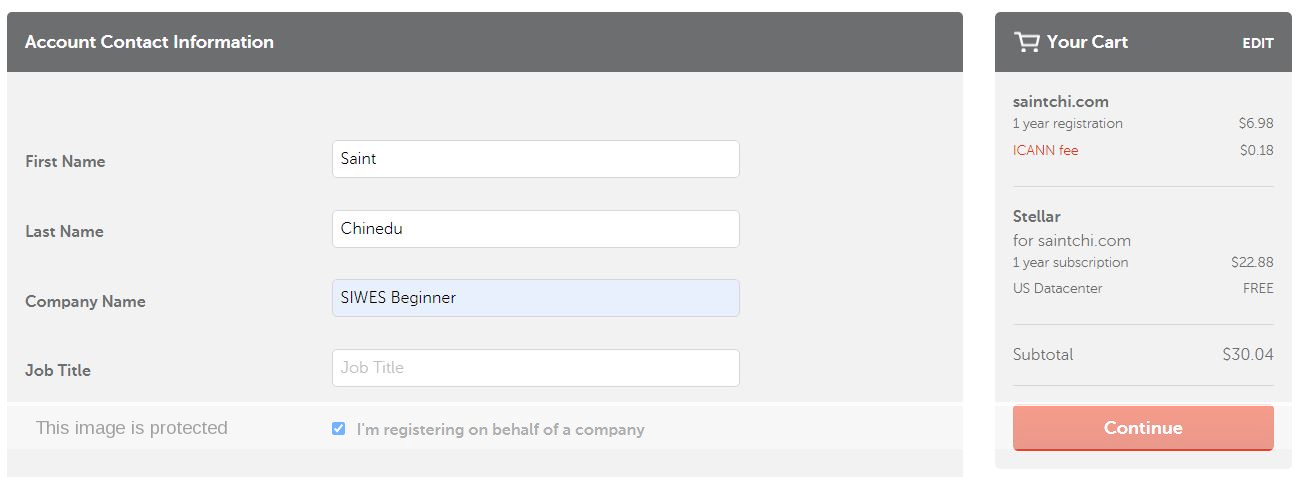
4. Go Check Your Email Address You used in Sign up
After your payment completion, Namecheap will immediately send you a welcome email containing your payment receipts and login details.
Visit your mailbox to login to your account.
5. Login Your Namecheap Account
With the newly created password and your domain name, log in to your Namecheap account.
From there, we’ll continue with the installation of WordPress.
6. Install WordPress and Set-Up
Yeah, we are almost done with the technical aspect of setting up a blog.
The last main stage is WordPress installation.
After creating your password and logging into your account, click on Hosting List.
Then, click on Go To CPANEL.
Youl’be redirected to the cPanel to login.
Once logged in, under SOFTACULOUS APPS INSTALLER, click on WordPress.

On the dashboard, click on Install Now.
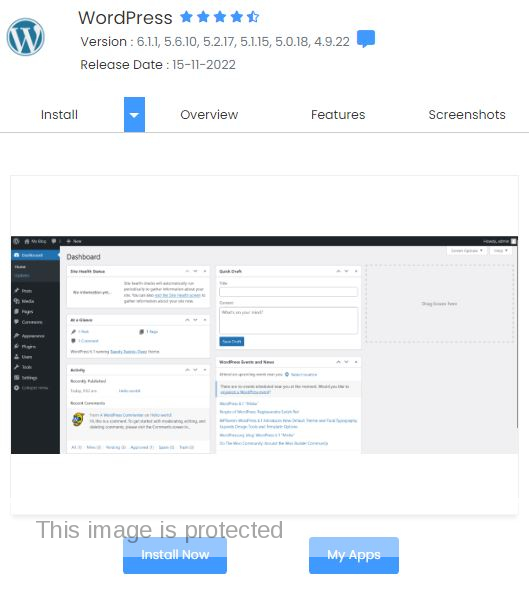
- Choose Installation URL.
- Choose the WordPress version you want to install.
- Choose a Site Name and Description.
- Create Admin Username and Password.
- Choose Language.
- Select Plugin(s) (optional).
- Select Theme (optional).
- Enter the correct email address the installation details will be sent to.
After installation, you’ll will receive your site login details via the email address you submitted.
7. Design Your Blog
With WordPress successfully installed, it is now safe to conclude that you are now ready to start a blog.
You should now log-in to the admin area of your blog and tweak the design.
The first thing to consider is to adjust the permalinks.
A permalink is the URL structure your blog posts will follow.
Navigate to Settings > Permalinks.
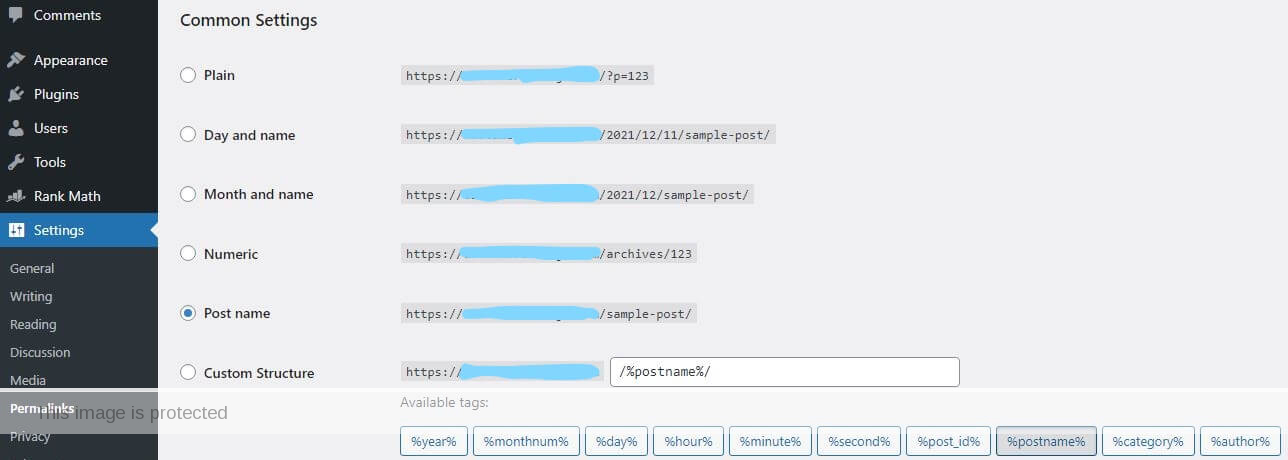
The “Post Name” option is the best for an SEO-friendly link. Choose it and save.
Also, you can choose your default WordPress URL directly from your WordPress dashboard.
Once in the dashboard, navigate to Settings > General.
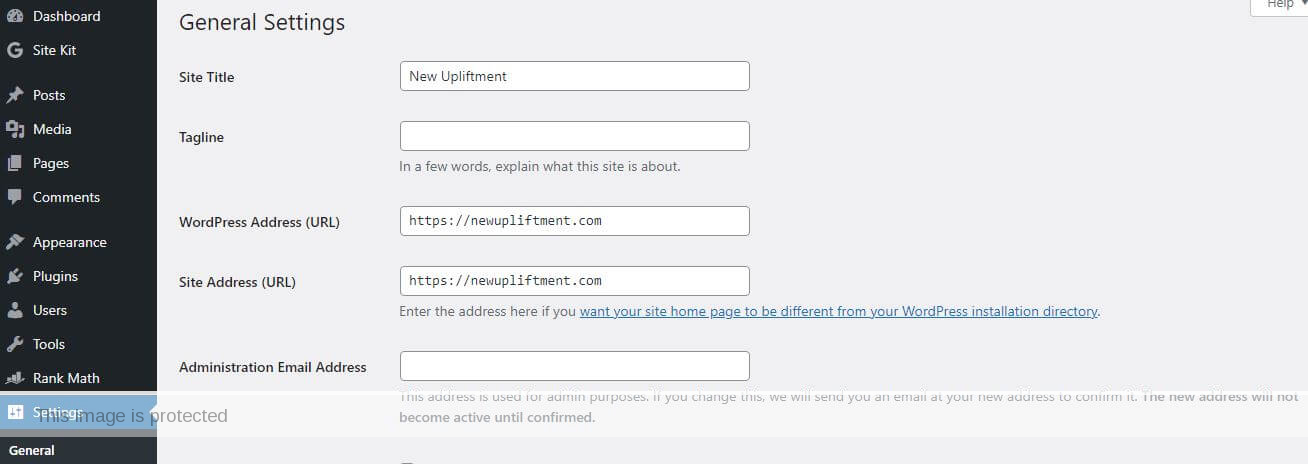 Ensure your site address and WordPress URL are both “https”, not “http”.
Ensure your site address and WordPress URL are both “https”, not “http”.
You can also add “www” to your URL, which is immediately after the double slash “//”.
8. Choose a Beginner Friendly WordPress Theme
The next task is to choose a theme with a responsive design for your blog which ensures your blog adapts to different devices, from mobile phones to full-fledged computers.
If you skip the stage of selecting a WordPress theme or you select any of the themes presented before, it’s time to select a better WordPress theme.
Here’s how to install a WordPress theme:
First, you need to login to your WordPress admin dashboard.
Right from your WordPress dashboard, click Appearance > Themes.
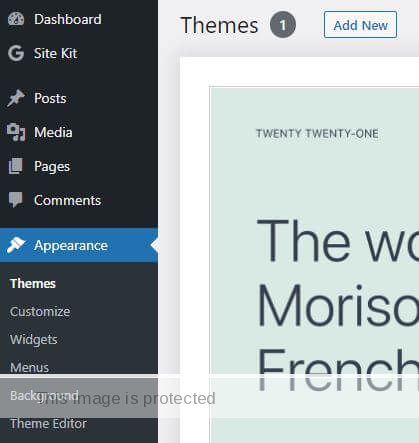
From here, you’ll click “Add New” to install a new WordPress theme from the stock of free themes offered by WordPress.
You can search for a theme e.g., Deadline using the box and select the theme.
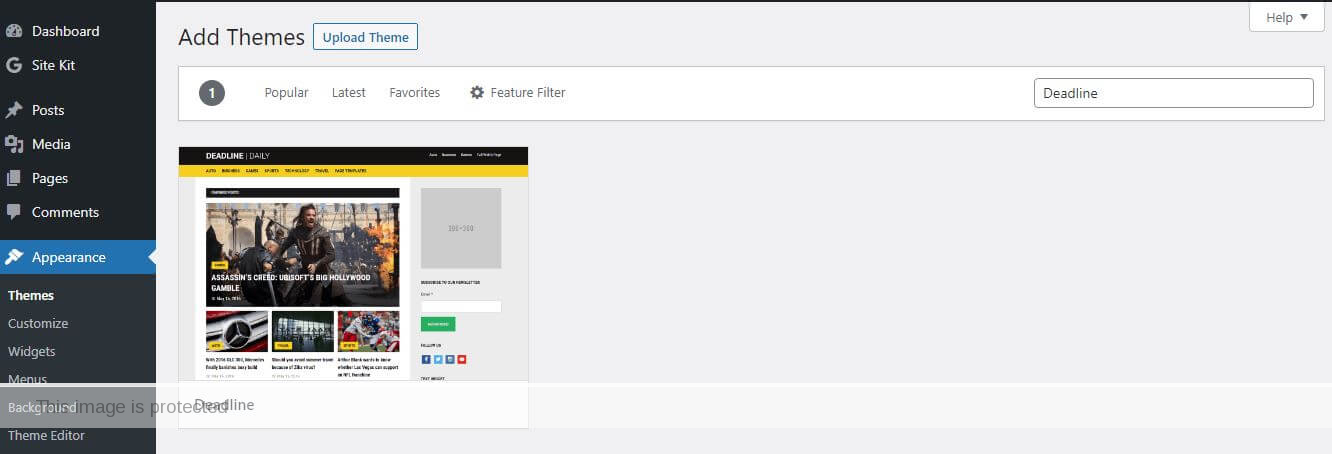
The next thing is to install the theme into your WordPress.
Note that installing doesn’t activate the theme on your blog.
You still need to activate the theme.
Because this is a new blog, you can activate the theme.
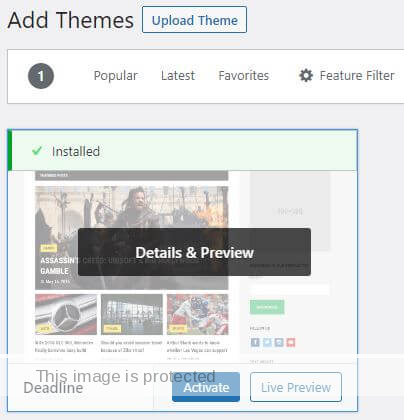
As you can see above, click Activate to launch the theme into your blog.
However, if you want to invest in a premium theme to give your blog a professional and polished look, the process is quite different.
You can get a premium theme from HappyThemes for as small as $40 for life-time use.
If you’re looking for a recommendation, I recommend MakeMoney WordPress Theme, as this is what I started with and besides, it is SEO optimized for Google. Fast as well.
If you purchase a premium theme, the process for installation is a little different from WordPress free themes.
For premium themes, you should have the zip folder on your computer when you buy the theme.
What you need to do is upload the theme.
You’ll find the upload button after clicking the “Add New” button.

Once you click, find a section to upload your zip folder as seen above.
Click Browse and select the file you want to upload.
Once selected, install the theme and activate.
9. Install Essential Plugins
To enhance the function of your blog, optimize it, make sure it loads quickly and delivers a great reader experience you will need to install and activate certain plugins.
Although you might need to install more plugins later (depending on your needs), the following are important plugins that you should install first:
- Yoast SEO or Rank Maths (for SEO)
- Classic Editor (for easier Writing)
- UpdradtPlus (for Backup and Storage of your site)
- Akismet
- Recent Posts Widget With Thumbnails
- Sassy Social Share
- Akismet (for protecting your blog from spam comments)
- WP Super Cache (for making your blog load faster)
To install a plugin, follow these steps:
- Click “Plugins” and click “Add New”.
- Write the name of the plugin you want to install in the search box, and click “Search”.
- Choose the plugin from the results page, install, and activate.
- Adjust the plugin settings to suit your needs.
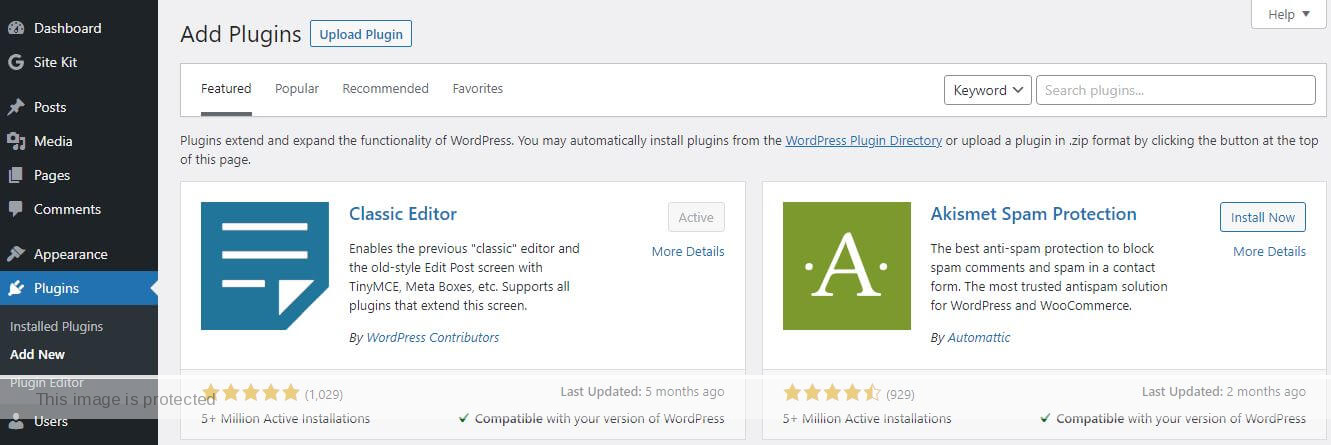
10. Write Necessary Pages
After installing the plugins, write your blog’s pages by clicking on the links on your dashboard.
Before you blog, try to create the following pages:
- An “About” page that tells your readers about you and your blog.
- A “Contact” page through which your readers can contact you.
- “Disclaimer”, “Privacy Policy” and “Terms of Service” pages.
- A “Hire Me” page that highlights the various services you can render for your readers (especially if you’re a freelancer).
You can check out my own About Page here.
11. Create Content and Start Blogging
After designing a great-looking blog, you will also add great content to it.
Avoid the temptation to type and publishing posts without a plan. Your blog won’t become a success that way.
Readers won’t stop by your site unless you create quality content that keeps them coming back for more.
You need to learn how to write good content for your blog.
In case you are wondering what a great content looks like.
Here is a brief characteristic of a great content:
- It is useful and has keywords in all the right places.
- It must answer a key question (or one key question and a couple of related questions).
- A great content must be unique, easy to read and understand, and includes images when necessary.
Note: Content is not necessarily just articles and text and images.
Content also includes videos, infographic, slideshows, podcast, webinar, etc.
I recommend choosing a consistent frequency for your articles.
Busier and larger websites post new content every day.
You can start by adding a few posts per week and then escalate your frequency to daily updates.
There are several reasons to post at least one article a week. One is user engagement.
If your readers notice you don’t post regularly on your blog, they’d go elsewhere to get hot and valuable information from a blog that’s more active than yours.
Another reason to write frequently is for SEO ranking.
Google runs through blogs regularly and will drop the page rankings of some that rarely post new content on their websites.
This is done because an inactive blog probably has old information, but an active blog always has new and valuable content.
To come up with regular blog post ideas, visit popular blogs in your niche to gather inspiration.
See what these top blogs are doing and replicate it on your blog.
I’m not saying that you should steal/recreate the same content.
If you copy articles from other websites and paste on your blog, Google will penalize you.
Google algorithm is very smart.
You just need to gather topics, collect ideas, and get inspiration.
After that, use those ideas on your blog by adding your own unique voice, style, and flavor to it.
As a beginner, content creation can be overwhelming, especially if you don’t have previous experience in writing.
Learning how to write isn’t hard at all.
Start by reading more, plan your content before writing, find your unique voice and keep writing.
But if you are not interested in going through the stress of writing your content yourself, there is good news for you; outsource your content writing.
While I don’t advise beginners to outsource their content, if you have some money to invest, that’s okay.
If you want to get quality articles written and delivered to you immediately, I recommend HIREWRITERS.COM
12. Sign up for Grammarly
As the name suggests, Grammarly is a software that automatically detects grammatical errors, spellings, word choices, punctuations, etc.
Grammarly’s algorithms identify potential errors in the text and suggest contextual corrections for grammar, spelling and usage, verbatim, style, punctuation, and even plagiarism.
This post you’re reading was edited and checked with Grammarly.
Grammarly is available for FREE.
But for advanced features, you can switch to the PRO version.
This tool helps you improvise your writing by suggesting corrections wherever necessary.
The primary functions of Grammarly are:
- Grammar checking
- Suggests proper punctuations
- Error-free writing
- Suggest word substitutes for quality writing
It gives you all the editing options and lets you draft the article if you are not writing for publishing purpose.
13. Implement Performance Tracking
Once you get several posts and writings under your belt (say 5 or 10 or more), you should then register your blog with search engine webmaster tools (like Google and Bing) and add tracking and analytics code (Google Analytics) to your blog.
The webmaster tools offer useful information about the SEO health of your blog.
Make sure you submit an XML sitemap to Google Search Console to help search engines index your site faster.
Tracking services like Google Analytics provides lots of useful information about your traffic and audience.
This will enable you to write better content to satisfy them.
14. Integrate Your Blog with Social Media
Social media sites like Facebook, Instagram, Twitter, etc. are a big deal these days with billions of users.
Therefore, your blog need to be on social media.
Open social media accounts for your blog. You don’t have to be in all of them.
Choose the social site that is used by most people in your niche.
Build your fans and regularly share your content with them.
Sharing your posts is very important because social is one of the signal search engines like Google use in determining relevance and authority.
15. Optimize Your Blog to Get More Visitors (SEO)
Once you add useful content, the next step is to make sure that users can find your website.
A great way to grow your brand is through Search Engine Optimization (SEO).
When writing your blog posts, always think this: “Will this rank on Google or any other search engine?”.
This is where either Yoast SEO or Rank Maths plugin comes in.
It is important you don’t just write to educate your audience, but you also write to rank on Google and other search engines.
Getting a high SEO ranking may take a while, but consistency and following the complete rules can get your articles to the front page of Google.
16. Improve Your Website Speed
Speed is one of the most important factors that affects user experience on your website.
It also affects your website’s search engine rankings as Google considers speed one of the top-ranking factors.
You can make your website significantly faster by implementing certain performance tweaks in WordPress.
17. Start Building an Email List
The biggest mistake many new and existing bloggers make is they don’t start building an email list from day one.
Most people will visit your blog once and never return, because they already have somewhere else, they get information on the type of content you’re offering.
The only way to get them back is to prompt them to sign up for your newsletter.
Your pop-up pitch must entice and, true to its word.
And every time they get an email from you on a new post, they’ll click to read, and overtime, come to trust your blog enough to visit it directly.
If you don’t build a mailing list from day one, your chances of becoming a successful blogger would be slim, because all your marketing expenditure could go down the drain when Facebook ads or pages, Google SEO, or any other marketing platform either goes down or blacklists you.
A great tool you can use to collect and send emails to your newsletter subscribers and blog readers, manage your marketing campaigns and keep track of your leads is GetResponse.
GetResponse makes all your emails and newsletters look great on all devices, automatically.
You can use GetResponse FREE Plan to get started today.
And when you’re ready to take your blog business and marketing to a new level, upgrade to one of the premium plans.
I equally use them, and their service is outstanding.
18. Promote Your Blog and Grow Your Audience
Promoting your blog is essential if you want to develop an audience and monetize it to earn money.
Some are easy to set up and do, while others require a little more investment of your time (and maybe your money).
- Optimize your blog for search engines to drive traffic to your blog.
- Pinterest, Instagram, Twitter, and TikTok can help build and grow your audience, as well as increase your monetization options since you’ll be getting more views on your content.
- There are a lot of social media channels out there, so you’ll have to decide which ones to use for your blog. It might tempt you to use them all, but don’t.
- Professional bloggers use email newsletters to stay engaged with their audiences and generate an income from them. They help you develop and sustain relationships with your audience better than any other marketing method you might use.
19. Monetize Your Blog
Once you have put in the effort of creating great blog content and promoting your blog, making money from your blog is the next motive.
Blogs have the potential to be extremely lucrative, but don’t assume that you’re going to make money in the first week, or even in the first month.
It could take six months to a year to see a steady stream of income.
I blogged for over 3 months before I made my first income online through my blog, and immediately I broke the jinx the income increases on a monthly basis.
Blogging takes work and dedication.
Once you develop a large audience, these are some ways you can employ to monetize your blog:
- Sell advertising space
- Sell affiliate products
- Sell your own products and services
- Sell digital downloads
- Sell memberships
Steps to Starting a Profitable Blog
Follow these steps to start a blog that pays daily income:
- Choose Your Blogging Niche
- Choose Blog Platform
- Purchase Domain Name and Web Hosting
- Go Check Your Email Address You used in Sign up
- Login Your Namecheap Account
- Install WordPress and Set-Up
- Design Your Blog
- Choose a Beginner Friendly WordPress Theme
- Install Essential Plugins
- Write Necessary Pages
- Create Content and Start Blogging
- Sign up for Grammarly
- Implement Performance Tracking
- Integrate Your Blog with Social Media
- Optimize Your Blog to Get More Visitors (SEO)
- Improve Your Website Speed
- Start Building an Email List
- Promote Your Blog and Grow Your Audience
- Monetize Your Blog
How much does it cost to start a blog?
The cost of starting and creating a blog depends on your blog type, platform, niche, size, required themes and plugins (i.e. free or paid).
Blog creation cost can range from $50 to $5,000.
So, with at least $50, you should be able to set up your own blog on WordPress using Namecheap.
How do I Start a Blog for Free and Make Money?
You can definitely create and start a free blog using blogging platforms like Wix, Blogger, etc.
But the issue here is that most of these platforms are for small blogs or aspiring bloggers that just want to practice first without thinking of making money online.
When you’re ready and interested in providing your readers value and solutions via helpful contents and earn money, you might have to switch to WordPress by making payment.
That’s why I’ll advise you to start with WordPress to avoid issues of switching later.
What about starting a blog with Facebook or Instagram?
Facebook and Instagram are outstanding, but you don’t own them.
You can build a huge following and all of this can go away immediately if these platforms decide that your content violated some of their policy.
I’m not saying that you shouldn’t use Facebook.
You can use it to build a large audience, but you will need a central platform that you can control where you can keep your audience coming back for years to come.
The best way to build your blog is by creating your own website with complete ownership and full control.
How Could a Beginner with No Knowledge of Coding Build a Website?
This is where WordPress.org comes in.
It is a powerful website builder which gives you absolute control and full ownership of your website.
It’s important not to confuse WordPress.org with WordPress.com. They’re two different platforms.
Here are the basic requirements you need to start a blog using WordPress.org:
- Passion and dedication.
- A Laptop. You can use your smartphone to blog, but to be honest, it will slow down your operation.
- Bank Credit/Debit Card for payment. Use VISA card, or Dollar Mastercard.
- Capital/Money. Have at least $50.
- Data (Internet Subscription).
- Domain Name and Web Hosting from Namecheap.
How Do Bloggers Get Paid?
Most new bloggers think when their blog visitors read their posts, their browsing airtime/data will be converted into cash.
I once thought like this a few years ago.
This is a false belief that is very common today.
After getting quality web traffic (i.e., your blog readers) from SEO or paid ads, bloggers only earn money and get paid when they monetize their blog via Google AdSense, affiliate marketing, selling of informational or physical products, display of native/banner ads, sponsored posts, consultation, services, etc.
Your blog monetization all depends on your audience and the content you’re creating.
How Much Does a Blogger Earn Online?
There is no limit to how much you can earn as a blogger.
On average, bloggers earn between $300 to $550,000 monthly.
Bloggers receive their money directly into their bank account through Wire Transfer, PayPal, Payoneer, Stripe, Skrill, Bank Deposits/Transfer, and Crypto.
Conclusion
To start a blog, first get your web hosting from Namecheap.
After that, create an account and checkout with your credit card details.
Then log in to your account and WordPress dashboard and start blogging.
Customize your blog and integrate all the essential plugins needed for your blog.
For quality content writing, I recommend HireWriters.com to get your articles written for you.
Once you’ve followed these steps, your blog will be properly set up and ready and you can now start publishing posts consistently. In fact, you’re now a blogger!
Do you have questions on blogging business, domain name, website setup or issues signing up via Namecheap?
Leave your comments below.
I wish you success in your blogging career.







A very excellent idea.
This post is really helpful, infact this is the best post of how to start a blog i have come across since i’ve been looking for better understand on how to blog.
I am ready.
Thank you sir, but is as good as reaching you when someone is faced with one or two doing this, please your number boss, adelekejulius12@gmail.com
Thanks So Much For The Information
Very informative. Thanks Saint Chinedu. I really want to start a blog but am helpless to do so even as I have gone thru your self explanatory article. But my challenge is that am not able to follow all the steps on my own I will need someone to help with every step of the way. Pls write me a message on my email. Thank you
I was so impressed reading this.
I want to start my own blog and I need your assistance.
WhatsApp Number is 07019313427.
Being encountering some problems in this website of a thing. My questions has been partialy answered.
Hoping on more articles.
I really love this article, pls bro can I get ur num through my email I have some questions to ask an I wil need ur help in some area bcos I want to start my blog this year, pls email me… okanrenny222@gmail.com…… Pls send me ur num through my mail so that I can call u pls, thanks
Hello sir I really love this and I will love to start my own blog on relationship therapist and daily ways of living, I will love to have you as my monitor and help me create my own blogging website too…..my number 08077960181
Wow I love this
More Anointing boss
I want to design a music blogg and I want you to help me with it sir
07086906090
Am a singer and music producer
Thanks
Wow I love this
This was really helpful. I’m just starting my blog and I’m so scared. I guess the difficult part for me is the framing of my words and how to write an article that will sell an idea or product. I’m really confused on how to go about all this. You make it sound so easy.
Great tips there, thanks for this.
This article was detailed and I do like it. Been hoping to start blogging for Years but have not. With this am willing to do so. Thanks a lot. I do appreciate. Kindly